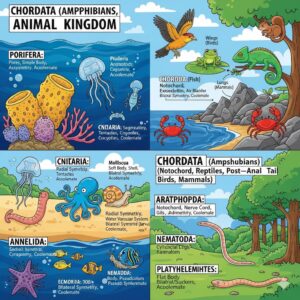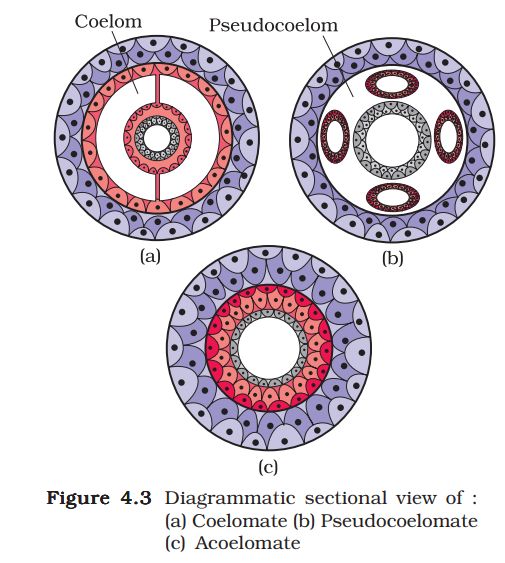1st PUC Biology Question and Answer: Animal Kingdom
Looking for 1st PUC Biology textbook answers? You can download Chapter 4: Animal Kingdom Questions and Answers PDF, Notes, and Summary here. 1st PUC Biology solutions follow the Karnataka State Board Syllabus, making it easier for students to revise and score higher in exams.
Karnataka 1st PUC Biology Textbook Answers—Reflections Chapter 4
Animal Kingdom Questions and Answers, Notes, and Summary
1st PUC Biology Chapter 4
Animal Kingdom
Scroll Down to Download Animal Kingdom PDF
Answer the Following:
Question 1.
What are the difficulties that you would face in the classification of animals If common fundamental features are not taken into account?
Answer:
If common fundamental features are not taken into account, classification of animals becomes difficult because animals differ in:
- Grade of organisation (cellular, tissue, organ, organ-system)
- Symmetry (radial or bilateral)
- Coelom (presence or absence of body cavity)
- Segmentation (metamerism)
- Notochord (presence or absence)
These fundamental features help group animals into categories or sub-categories. For example, all birds have forelimbs modified for flying, which helps classify them under Aves.
Question 2.
If you are given a specimen, what are the steps that you would follow to classify it?
Answer:
To classify a given specimen, the following features are considered:
- Level of Organisation – Identify whether it is cellular, tissue, organ, or organ-system level.
- Body Symmetry – Determine if the animal is asymmetrical, radially symmetrical, or bilaterally symmetrical.
- Diploblastic or Triploblastic – Check the number of embryonic germ layers:
- Diploblastic: 2 layers (ectoderm and endoderm)
- Triploblastic: 3 layers (ectoderm, mesoderm, endoderm)
- Body Cavity (Coelom) – Check for presence or absence of a body cavity:
- Coelomates: body cavity present
- Acoelomates: body cavity absent
- Segmentation – Observe if the body is externally or internally segmented.
- Presence of Notochord – Animals with a notochord are chordates; those without are non-chordates.
These features help in assigning the specimen to its appropriate phylum or class.
Question 3.
How useful is the study of Body cavity and coelom in the classification of animals?
Answer:
The presence or absence of a body cavity (coelom) is very important in the classification of animals.
- Coelomates: Animals with a true coelom lined by mesoderm (e.g., Annelids, Mollusca, Echinoderms, Chordates).
- Pseudocoelomates: Animals with a body cavity not fully lined by mesoderm, where mesoderm occurs as scattered pouches between ectoderm and endoderm (e.g., Aschelminthes).
- Acoelomates: Animals in which the body cavity is absent (e.g., Platyhelminthes).
The type of coelom indicates the evolutionary and structural complexity of the animal:
- Acoelomates are primitive and placed lower in the classification ladder.
- Pseudocoelomates are intermediate.
- Coelomates are more advanced and highly developed.
Question 4.
Distinguish between intracellular and extracellular digestion?
Answer:
Feature | Intracellular Digestion | Extracellular Digestion |
Definition | Digestion takes place inside the cells in food vacuoles. | Digestion takes place outside the cells in a digestive cavity or gut. |
Site | Inside food vacuoles of cells | Gastrovascular cavity or alimentary canal |
Enzymes | Enzymes are secreted into food vacuoles | Enzymes are secreted into the gut cavity |
Example | Sponges (Porifera) | Coelenterates (Cnidaria), Molluscs, Humans |
Summary:
Intracellular digestion occurs inside cells, whereas extracellular digestion occurs outside cells in a digestive cavity or gut.
Question 5.
What is the difference between direct and indirect development?
Answer:
- Direct development: Young resemble the adult; no larval stage (e.g., Ascaris, Birds, Mammals).
- Indirect development: Young do not resemble the adult; passes through larval stage (e.g., Frog, Butterfly).
Question 6.
What are the peculiar features that you find in parasitic platyhelminthes?
Answer:
Parasitic Platyhelminthes have hooks and suckers for attachment to the host. Some absorb nutrients directly through their body surface instead of using a digestive system.
Examples: Taenia (Tapeworm), Fasciola (Liver fluke).
Question 7.
What are the reasons that you can think of for the arthropods to constitute the largest group of the animal kingdom?
Answer:
Arthropods constitute the largest group of the animal kingdom due to the following reasons:
- They are the first phylum to have well-developed digestive, circulatory, and respiratory systems.
- Their body is covered by a chitinous exoskeleton, which protects them and helps them survive even in extreme conditions.
- They are usually small in size and reproduce in large numbers, which increases their population rapidly.
- They possess highly developed sensory organs like antennae, compound and simple eyes, and statocysts, which help them escape predators.
- They are highly adaptable to all habitats – land, water, air, and even extreme environments like volcanic springs.
Thus, their adaptability, protection, and reproductive capacity make them the largest group of the animal kingdom.
Question 8.
Water vascular system is the characteristic of which group of the following:
(a) Porifera
(b) Ctenophora
(c) Echinodermata
(d) Chordata
Answer:
(c) Echinodermata ✅
Question 9.
“All vertebrates are chordates but all chordates are not vertebrates”. Justify the statement.
Answer:
All chordates have a notochord present in some stage of their life cycle. In vertebrates, this notochord is replaced by a vertebral column during the adult stage, which makes them more advanced. However, some chordates like Urochordates (Ascidia) and Cephalochordates (Amphioxus) retain the notochord but do not develop a vertebral column.
Therefore, all vertebrates are chordates, but all chordates are not vertebrates.
Question 10.
How important is the presence of air bladder in Pisces?
Answer:
The air bladder (also called swim bladder) in Pisces is very important because:
- It helps in buoyancy regulation, allowing the fish to float at different depths without much effort.
- It reduces energy consumption during swimming.
- In some fishes, it also helps in respiration and acts as an accessory respiratory organ.
- It may also function in sound production and reception in certain species.
Note: Fishes without an air bladder (like sharks) must swim continuously to avoid sinking.
Question 11.
What are the modifications that are observed in birds that help them fly?
Answer:
Birds show several modifications for flight:
- Body shape – Streamlined body reduces air resistance.
- Forelimbs modified into wings – Used for flight.
- Feathers – Provide insulation and aid in flying.
- Light body weight – Due to hollow (pneumatic) bones.
- Strong flight muscles – Especially pectoral muscles attached to a keeled sternum.
- Efficient respiratory system – Presence of air sacs ensures continuous oxygen supply.
- High metabolic rate – Helps generate the energy required for flying.
- Absence of urinary bladder – Reduces body weight.
- Fused bones – Provide rigidity and strength for flight.
Question 12.
Could the number of eggs or young ones produced by an oviparous and viviparous mother be equal? Why?
Answer:
No, the number of eggs or young ones produced by an oviparous and viviparous mother cannot be equal.
- Oviparous animals (egg-laying) produce a large number of eggs, because the eggs are exposed to environmental hazards and many do not survive.
- Viviparous animals (give birth to young ones) produce fewer offspring, since the developing embryo is protected inside the mother’s body, ensuring higher chances of survival.
Thus, oviparous mothers produce more eggs, while viviparous mothers produce fewer but better-protected young ones.
Question 13.
Segmentation in the body is first observed in which of the following:
(a) Platyhelminthes
(b) Aschelminthes
(c) Annelida
(d) Arthropoda
Answer:
(c) Annelida ✅
Question 14.
Match the following:
Answer:
(a) Operculum → (viii) Osteichthyes
(b) Parapodia → (v) Annelida
(c) Scales → (iv) Reptilia
(d) Comb plates → (i) Ctenophora
(e) Radula → (ii) Mollusca
(f) Hairs → (vii) Mammalia
(g) Choanocytes → (iii) Porifera
(h) Gill slits → (vi) Cyclostomata and Chondrichthyes
Question 15.
Prepare a list of some animals that are found parasitic on human beings.
Answer:
Some animals that are parasitic on human beings are:
- Entamoeba histolytica – causes amoebic dysentery
- Plasmodium (vivax, falciparum, malariae) – causes malaria
- Taenia solium (Pork tapeworm) – causes taeniasis
- Fasciola hepatica (Liver fluke) – infects the liver
- Ascaris lumbricoides (Roundworm) – causes ascariasis
- Wuchereria bancrofti (Filarial worm) – causes filariasis
- Enterobius vermicularis (Pinworm) – causes itching in anal region
- Pediculus humanus (Louse) – ectoparasite on human body
- Leishmania donovani – causes kala-azar (leishmaniasis)
- Trypanosoma – causes sleeping sickness.
Additional Questions & Answers
Question 1.
Define Metagenesis.
Answer:
Metagenesis or alternation of generations is the phenomenon in some coelenterates where a polyp produces medusae asexually, and medusae form polyps sexually.
Example: Obelia.
Question 2.
What is the significance of segmentation in animals?
Answer:
Segmentation (metamerism) allows specialization of body regions, better locomotion, and redundancy of organs, helping survival.
Example: Earthworm (Annelida).
Question 3.
Differentiate between coelomates, pseudocoelomates, and acoelomates.
Feature | Coelomates | Pseudocoelomates | Acoelomates |
Body cavity | Present, lined by mesoderm | Body cavity partially lined by mesoderm | Absent |
Exampls | Annelida, Mollusca, Arthropoda, Chordata | Aschelminthes | Platyhelminthes |
Question 4.
Name two examples each of aquatic and terrestrial molluscs.
Answer:
- Aquatic: Pinctada (Pearl oyster), Octopus
- Terrestrial: Pila (Apple snail), Achatina (Giant African snail)
Question 5.
What are the unique features of echinoderms?
Answer:
- Endoskeleton of calcareous ossicles
- Radial symmetry in adults, bilateral in larvae
- Water vascular system for locomotion, food transport, and respiration
- No excretory system
Examples: Asterias (Starfish), Echinus (Sea urchin)
Question 6.
Mention the distinctive features of protochordates.
Answer:
- Small marine animals
- Notochord present throughout life (Cephalochordata) or in larval tail only (Urochordata)
- Dorsal hollow nerve cord
- Pharyngeal gill slits
Examples: Ascidia (Urochordata), Branchiostoma (Cephalochordata)
Question 7.
What are placoid scales? Which class of animals has them?
Answer:
Placoid scales are tiny, tooth-like structures on the skin of cartilaginous fishes, providing protection and reducing friction in water.
Class: Chondrichthyes
Examples: Scoliodon (Dogfish), Carcharodon (Great white shark)
Question 8.
Why do amphibians need moist skin?
Answer:
Amphibians have moist skin for cutaneous respiration (gas exchange through skin) since their lungs alone are insufficient.
Examples: Frog, Salamander
Question 9.
Write two differences between poikilotherms and homoiotherms.
Answer:
Feature | Poikilotherms | Homoiotherms |
Body temperature | Varies with environment | Constant body temperature |
Examples | Fish, Amphibians, Reptiles | Birds, Mammals |
Question 10.
Give two examples of viviparous and oviparous mammals.
Answer:
- Viviparous: Camel, Dog, Human
- Oviparous: Ornithorhynchus (Platypus), Echidna


